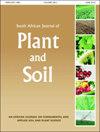Impact of liming on extractable phosphorus, exchangeable base cations, and effective cation exchange capacity of eastern Free State soils
IF 0.7
Q3 AGRONOMY
引用次数: 1
Abstract
Soil acidity can adversely affect wheat production in the eastern Free State, South Africa. Liming of the soils is therefore essential. The aim of this study was to establish whether extractable phosphorus (P), exchangeable calcium (Ca), magnesium (Mg) and potassium (K) concentrations and cation ratios remained within recommended ranges after liming. Incubation and field studies were done on soils of wheat fields at Kestell, Fouriesburg, Prinsloo and Melrose in the eastern Free State, South Africa. Lime was applied at different rates to induce soil acidity ranges for determination of Bray 1 extractable P and ammonium acetate (NH4OAc) exchangeable Ca, Mg and K concentrations. Cation ratios (Ca:Mg, Mg:K and (Ca + Mg):K) and effective cation exchange capacity (ECEC) were also calculated. Apart from the Prinsloo soil, liming decreased extractable P concentration only in the incubation study. In the incubation and field studies exchangeable Ca and Mg concentrations increased while exchangeable K concentration remained unchanged. Despite liming of the soils, exchangeable Ca and Mg concentrations at Kestell and Fouriesburg were still less than the required thresholds. The Ca:Mg ratio decreased at both sites while the Mg:K and (Ca + Mg):K ratios increased with liming. Liming increased ECEC of all soils at all four sites. Our results show that liming does not always result in the recommended cation levels required for soil fertility.石灰化对东部自由邦土壤可提取磷、交换碱阳离子和有效阳离子交换能力的影响
土壤酸度会对南非东部自由邦的小麦生产产生不利影响。因此,对土壤进行石灰处理至关重要。本研究的目的是确定脱泥后可提取磷(P)、可交换钙(Ca)、镁(Mg)和钾(K)的浓度以及阳离子比例是否保持在推荐范围内。在南非自由邦东部的Kestell、Fouriesburg、Prinsloo和Melrose的麦田土壤上进行了培育和田间研究。以不同速率施用石灰诱导土壤酸度范围,测定Bray-1可提取的P和乙酸铵(NH4OAc)交换性Ca、Mg和K的浓度。还计算了阳离子比(Ca:Mg、Mg:K和(Ca+Mg):K)和有效阳离子交换容量(ECEC)。除Prinsloo土壤外,施用石灰仅在培养研究中降低了可提取的磷浓度。在培养和田间研究中,可交换的Ca和Mg浓度增加,而可交换的K浓度保持不变。尽管对土壤进行了石灰处理,但Kestell和Fouriesburg的交换性Ca和Mg浓度仍低于要求的阈值。两个位点的Ca:Mg比值均下降,而Mg:K和(Ca + Mg)∶K比值随石灰的添加而增加。黎明提高了所有四个地点所有土壤的EC。我们的研究结果表明,施用石灰并不总是达到土壤肥力所需的推荐阳离子水平。
本文章由计算机程序翻译,如有差异,请以英文原文为准。
求助全文
约1分钟内获得全文
求助全文
来源期刊

South African Journal of Plant and Soil
Agricultural and Biological Sciences-Plant Science
CiteScore
1.90
自引率
11.10%
发文量
32
期刊介绍:
The Journal has a proud history of publishing quality papers in the fields of applied plant and soil sciences and has, since its inception, recorded a vast body of scientific information with particular reference to South Africa.
 求助内容:
求助内容: 应助结果提醒方式:
应助结果提醒方式:


